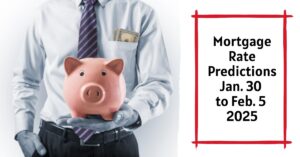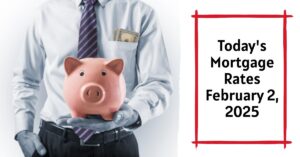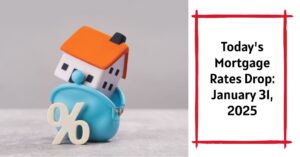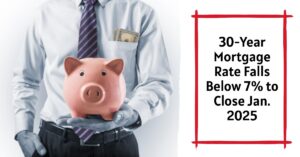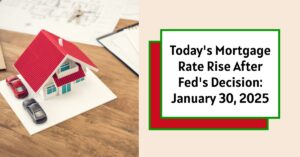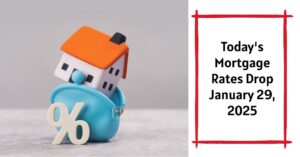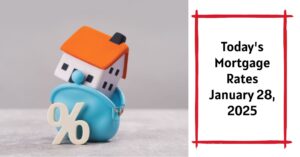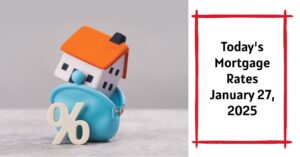So, you're looking to buy a home or refinance your current mortgage and wondering what the future holds for interest rates? It's the question on everyone's mind! Well, based on a recent expert poll, here’s the scoop: a slight majority of experts (47%) believe that mortgage rates are likely to go down between January 30th and February 5th, 2025. While that is a hopeful sign, let's dive deeper into what could be driving these predictions, and how you can make sense of it all.
Mortgage Rate Predictions for Week Jan 30 – Feb 5 2025
It's important to note that nothing in the financial world is guaranteed, but getting a glimpse of the expert views can help in your planning. As someone who's been following the mortgage market for a while, I can tell you that these fluctuations can feel like a rollercoaster. But with some understanding, we can navigate this journey together!
What the Experts Are Saying: A Deep Dive
The opinions of experts in the mortgage market are valuable because they often have access to information and insights that the average person does not. Here's a breakdown of the sentiment that's making the rounds, as reported by Bankrate:
1. The Optimists (47%): Predicting a Rate Drop
- The “Trump Effect”: Some experts are attributing a potential drop in rates to increased investor confidence following the new administration's economic agenda. I've seen this kind of market response in the past – the market can be very sensitive to policy changes. This is not to say that the changes are right or wrong – the point is markets often respond to any change, regardless.
- Wall Street Volatility: Others believe that general volatility in the stock market could push investors towards safer investments like bonds and Treasuries, which can drive mortgage rates down. This is a classic “flight to safety” move – when stocks seem risky, bonds often become more attractive.
- Weakening Economic Data: A few experts point towards weaker-than-expected corporate earnings and economic reports as a potential reason for lower rates. When the economy shows signs of slowing, the Federal Reserve has been known to lower rates.
- The “DeepSeek” Scare: One expert even referenced a supposed scare in the AI world, which caused investors to flock to safer options, pushing rates down. While this may sound like a bit of an outlier, these things can occasionally influence investment behavior.
- The Debt-Worries are Fading: One opinion I find very interesting is that the worry over the US debt seems to be dissipating among investors, resulting in higher demand for bonds and lower yields, resulting in lower mortgage rates.
2. The “Stay-the-Course” Camp (40%): Expecting Flat Rates
- The Fed's Stance: A strong contingent of experts think that since the Federal Reserve (the Fed) has held steady on the federal funds rate, mortgage rates will also likely remain stable. Their argument is that the Fed's current position is to maintain rates until they see consistent progress towards their 2% inflation goal.
- Strong Economy Argument: The Fed has stated that the economy is strong and that the labor market is balanced. Some experts concur that no rate cuts are imminent. In my opinion, this is a sound observation.
- Data-Dependent: Some are in a “wait-and-see” mode, believing that rates will remain unchanged until there’s clear and convincing data to suggest otherwise. The next non-farm payroll report next Friday will be a key data point.
- No Movement Expected: A few experts simply believe that since the Fed didn't change rates, mortgage rates won't move much either.
- Inflation is the Key: One expert stated that if mortgage rates will come down, inflation must come down, and that, lately, it has not. This is a very important observation to keep in mind.
3. The Pessimists (13%): Predicting Rate Increase
- Minor Fluctuations: One expert feels that we will experience minor fluctuations due to market dynamics, but significant changes are unlikely, unless unexpected economic or geopolitical issues arise.
- Long Game: This particular expert seems to believe that the trend will be towards higher rates, even though the Fed's current stance suggests a cautious approach.
- Inflationary Pressures: This expert is also concerned that the Fed is trying to balance solid economic growth with worries about persistent inflation.
My Take on These Predictions
Having seen the mortgage market move up and down over the years, I think there's wisdom in looking at all sides. Here’s my two cents on the matter:
- The “Slightly Downward” Trend: I am leaning towards a slightly downward trend in mortgage rates for the week of Jan 30th – Feb 5th. The market does appear to be in a “wait and see” mode, but the number of experts who think rates will go down, gives me a bit of optimism.
- Don't Expect Big Drops: But, I wouldn't expect rates to plummet dramatically. It’s more likely we will see a gradual easing, if any, than a sudden drop.
- Be Prepared for Volatility: The market can be unpredictable. Geopolitical events, changes in government policy, or surprise economic data can swing the pendulum the other way. This is something that no one can predict with accuracy.
- The Fed Holds the Cards: Ultimately, the Fed's decisions will play a significant role in the mid-to-long-term movement of mortgage rates. While some may see the Fed as “data-dependent”, we all know that the Fed will make decisions in its best interest, as it sees fit.
Recommended Read:
Mortgage Rate Predictions for Jan 27 to Feb 2, 2025
Factors Influencing Mortgage Rates
To really grasp these predictions, let’s look at the factors that push mortgage rates up or down:
- Federal Funds Rate: This is the interest rate at which commercial banks borrow and lend money from each other overnight. While the Fed does not directly set mortgage rates, it significantly influences them. This is because it affects the overall cost of borrowing in the economy.
- Inflation: Inflation erodes the value of money and can push interest rates higher. The Fed wants to keep inflation around 2% and uses monetary policy tools to manage inflation.
- Economic Data: Reports like jobs data, GDP growth, and consumer price indices can impact investor sentiment and influence the bond market which impacts mortgage rates.
- Bond Market: The yield on 10-year US Treasury bonds is often a good indicator of where mortgage rates are heading. When bond yields drop, mortgage rates tend to follow. This can lead to higher demand for mortgage-backed securities, potentially lowering mortgage rates.
- Geopolitical Events: Unexpected global events can create uncertainty, affecting investment patterns and driving mortgage rates in one direction or the other.
- Investor Sentiment: The general mood of the market – whether investors are feeling optimistic or pessimistic – can sway rate movement.
What This Means for You
If you are in the market for a new home, or looking to refinance, this information could impact your decision. Here’s what I recommend:
- Stay Informed: Keep an eye on the market and pay attention to economic news. Subscribe to reputable sources, and follow financial blogs.
- Don't Panic: Don’t make rash decisions based on short-term rate fluctuations. Mortgage decisions should be based on your long-term financial goals.
- Consider Your Risk Tolerance: If you're very risk-averse, then it is okay to wait for more clarity. If you can take a bit of a risk, then it’s okay to move forward.
- Shop Around: Do not just stick to one lender. It makes sense to shop around for the best rates. Mortgage rates can vary among lenders.
- Talk to Experts: Consult with mortgage professionals who can provide advice based on your specific financial situation.
- Use Calculators: Use mortgage calculators to estimate your monthly payments, but remember that the actual numbers could be slightly different.
- Do the Math: Think about what you can afford. It's best not to push your finances to the limit.
Final Thoughts
The week of January 30th to February 5th, 2025, could see mortgage rates easing slightly, but it’s important to be prepared for anything. As a homeowner, and someone who's been tracking financial markets for some time, I know how important it is to take a measured approach. By staying informed, consulting with experts, and understanding the various factors that influence the mortgage market, you can make smart decisions for your future. Remember, real estate is a long-term game, and having a solid plan is the key to success.
Work with Norada in 2025, Your Trusted Source for
Real Estate Investing
With mortgage rates fluctuating, investing in turnkey real estate
can help you secure consistent returns.
Expand your portfolio confidently, even in a shifting interest rate environment.
Speak with our expert investment counselors (No Obligation):
(800) 611-3060
Recommended Read:
- Mortgage Rates Forecast for the Next 3 Years: 2025 to 2027
- 30-Year Mortgage Rate Forecast for the Next 5 Years
- 15-Year Mortgage Rate Forecast for the Next 5 Years
- Why Are Mortgage Rates Going Up in 2025: Will Rates Drop?
- Why Are Mortgage Rates So High and Predictions for 2025
- NAR Predicts 6% Mortgage Rates in 2025 Will Boost Housing Market
- Mortgage Rates Predictions for 2025: Expert Forecast
- Will Mortgage Rates Ever Be 3% Again: Future Outlook
- Mortgage Rates Predictions for Next 2 Years
- Mortgage Rate Predictions for Next 5 Years
- Mortgage Rate Predictions for 2025: Expert Forecast
- Mortgage Rate Predictions: Why 2% and 3% Rates are Out of Reach
- How Lower Mortgage Rates Can Save You Thousands?
- How to Get a Low Mortgage Interest Rate?
- Will Mortgage Rates Ever Be 4% Again?
